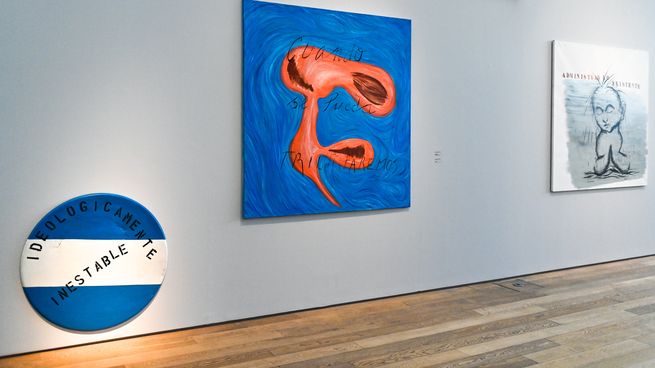The unique exhibition, curated by Roberto Amigo, is titled “On the margin full of doubts” (in allusion to debates in the 90s at the Rojas Cultural Center), and is presented in the Amalita Collection of the Fortabat Museum.
In the Collection Amalite from the Fortabat Museumthe artist Gustavo Marrone (1962) presents the exhibition “On the sidelines full of doubts”. Dedicated to rescuing the power of the word and curated by Roberto Amigothe exhibition establishes a close relationship with the life of brown. “At the beginning of this century, based in Barcelona, he decided to give visual centrality to an element present in his work, the word as an image, and displace the omnipresence of the representation of the body since the eighties”observe Friend.
The content you want to access is exclusive to subscribers.
The title of the exhibition is an open reference to the already famous discussion days of the Rojas Cultural Center called, first, “Beyond any doubt: painting”and then “Beyond any doubt?”. The debates held in Rojas in 1993 took place while brown I was “on the margins”, in Barcelona. Much has been written on the topic that is the subject of study today. There were the supporters of a painting of intense gestures, with an expressive, passionate and at times, mournful character.


The most important protagonist was Marcia Schvartzperhaps the greatest defender of painting to date. On the other hand, at CC Rojas, Jorge Gumier Maier confronted painters with an art considered “light” and “meaningless” dedicated to “the insignificant.” The echoes of these debates reached Barcelona. And in the trajectory of brown There are some exhibitions along with the exponents of painting and also of art without content, such as Cristina Schiavi. “In the face of those opposing certainties, Marrone has been constant in choosing the instability between meaning and reason in the construction of images”points out Roberto Amigo.
Yes ok brown He lived in Barcelona between 1988 and 2011, he was never unknown. His identity was familiar to people in the art world thanks to the expressive portrait he painted in 1988. Marcia Schvartz and which is exhibited to this day by the National Museum of Fine Arts. Comfortably seated in an old armchair in the middle of his workshop, the artist wears a light blue shirt and a dark suit, the white stockings stand out in the painting and give him a studied elegance. The dark, angular face is not easy to forget. And at the beginning of the Fortabat sample, as if brown It would be difficult for him to comply with the premise of privileging the word, he self-portrays. “With eyes closed” The name is the character who rubs his eyes as if they were burning and, above him, there is a sign that reads: “I see too much”.
brown says that he always felt “an artist in transit” and awakens the viewer’s curiosity when approaching the subject. Some texts are drawn on black cloth with black backgrounds that make reading difficult. After straining your eyes and reading: “Could someone have come out of that door? “it is perceived that this question, far from facilitating the understanding of an idea, makes it more complex. There are other texts painted on various formats and supports that, in general, show a high degree of humor. A good example is “Ideologically unstable” either “When we can we will succeed”.
And there is a series of posters of the important Quam residences. The Montesquieu Art Fortnight in Barcelona, linked to Latin America because it was promoted Balmesan exile during the dictatorship of Pinochet. At his side and on the floor, more than a hundred magaziness “New City” They draw a colorful rectangle. But beyond the color and images, for the artist the headlines, the meaning of the words, mostly stimulating, count. “To educate is to create” either “Make another model.”
Humanistic culture has trusted over time in the power of the word, and in particular that of the written and read word. Libraries have been perceived as the brain or conscience of our civilization, reservoirs of words. The grace of the sample brown resides in the links that universal knowledge establishes with its own history. The curator points out that the texts “They come from various sources, but mainly from the pages of gay social contacts, statements by politicians, media covers or from the artist’s inventiveness”. Thus, he emphasizes that from the moment of selection he notices an ironic look. And adds: “Marrone affirms the crisis of the contiguity between truth-image-word”.
Perhaps in this search “he makes a decision: silence the color. Perhaps, with it, also the enjoyment”. The deprivation of the enjoyment that color provides for a visual artist invites us to compare that feeling with the one he describes. Marcelo Cohen referring to the poet Philip Larkin. Cohen talks about the theory that affirms that the aristocratic vision of culture “pushed Pound towards messianism and admiration for Mussolini” and, in this way, clarifies that, in reality, “Larkin more cautiously believed that, when the poet loses touch with seekers of literary pleasure, he has lost his only worthwhile audience.”.
Source: Ambito
I am an author and journalist who has worked in the entertainment industry for over a decade. I currently work as a news editor at a major news website, and my focus is on covering the latest trends in entertainment. I also write occasional pieces for other outlets, and have authored two books about the entertainment industry.




